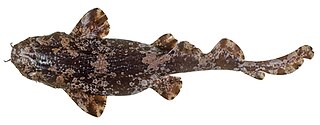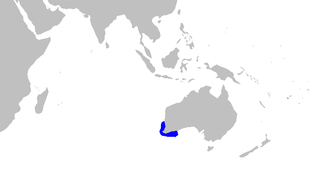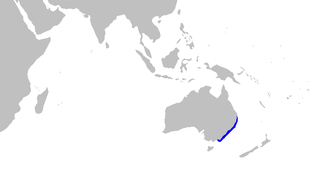
A tuna is a saltwater fish that belongs to the tribe Thunnini, a subgrouping of the Scombridae (mackerel) family. The Thunnini comprise 15 species across five genera, the sizes of which vary greatly, ranging from the bullet tuna up to the Atlantic bluefin tuna, which averages 2 m (6.6 ft) and is believed to live up to 50 years.

Mackerel is a common name applied to a number of different species of pelagic fish, mostly from the family Scombridae. They are found in both temperate and tropical seas, mostly living along the coast or offshore in the oceanic environment.

Herring are forage fish, mostly belonging to the family of Clupeidae.

Sardine and pilchard are common names for various species of small, oily forage fish in the herring family Clupeidae. The term sardine was first used in English during the early 15th century; a somewhat dubious folk etymology says it comes from the Italian island of Sardinia, around which sardines were once supposedly abundant.

Wobbegong is the common name given to the 12 species of carpet sharks in the family Orectolobidae. They are found in shallow temperate and tropical waters of the western Pacific Ocean and eastern Indian Ocean, chiefly around Australia and Indonesia, although one species occurs as far north as Japan. The word wobbegong is believed to come from an Australian Aboriginal language, meaning "shaggy beard", referring to the growths around the mouth of the shark of the western Pacific.

The cobbler wobbegong, Sutorectus tentaculatus, is a carpet shark in the family Orectolobidae, the only member of the genus Sutorectus. It is found in the subtropical eastern Indian Ocean around Western Australia between latitudes 26° S and 35° S. It is frequently found in rocky and coral reef areas. Cobbler wobbegongs reach a length of 92 cm. It has unbranched dermal lobes on the head, rows of warty tubercles along the back and black spots on the body and fins.

The Australian marbled catshark is a catshark of the family Scyliorhinidae, found in the eastern Indian Ocean, endemic to Western Australia between latitudes 12 and 21°S, from the surface to 245 m (800 ft) deep. Its length is up to 60.0 cm, and it typically inhabits coastal waters with sandy or rocky bottoms.

The Australian blackspotted catshark is a catshark of the family Scyliorhinidae in the order Carcharhiniformes.

The gray smooth-hound is a houndshark of the family Triakidae. It is found on the continental shelves of the subtropical eastern Pacific, from northern California to the Gulf of California, between latitudes 40° N and 23° N, to a depth of 46 m. It can grow up to a length of 1.24 m.

The Australian spotted catshark is a catshark of the family Scyliorhinidae, found only around Australia between 32 and 38°S, at depths between 10 and 180 m. It can grow up to 90 cm. Females of this species were observed as being reproductive year round. They are also confirmed as being a single oviparous species.

The orange-spotted catshark or rusty catshark, is a species of catshark, and part of the family Scyliorhinidae. It is found only off the coast of Western Australia, at depths between 25 and 540 m. Its length is up to 39 cm (15 in).

Eels are ray-finned fish belonging to the order Anguilliformes, which consists of eight suborders, 19 families, 111 genera, and about 800 species. Eels undergo considerable development from the early larval stage to the eventual adult stage and are usually predators.

An anchovy is a small, common forage fish of the family Engraulidae. Most species are found in marine waters, but several will enter brackish water, and some in South America are restricted to fresh water.

Cyprinion is a genus of ray-finned fish in the family Cyprinidae.

Cyprinion kais, the Kais kingfish or smallmouth lotak, is a species of ray-finned fish in the genus Cyprinion. It is found in the drainage basins of the rivers Tigris and Euphrates, and was also found in the Queiq system but it appears to have been extirpated from that basin following the drying up of that river. Its range covers Turkey, Syria, Iraq and Iran. Its preferred habitat is flowing water in larger warm streams and rivers from where it migrates to canals and probably to other artificial water bodies to forage.
Cyprinion milesi is a species of ray-finned fish in the genus Cyprinion from Pakistan, Afghanistan and Iran.
Cyprinion microphthalmum is a species of ray-finned fish in the genus Cyprinion. This species may be a synonym of Cyprinion watsoni. If valid it is found in Iran, Pakistan, Afghanistan and the Arabian peninsula.
Cyprinion acinaces acinaces is a subspecies of Cyprinion acinaces.
This page is based on this
Wikipedia article Text is available under the
CC BY-SA 4.0 license; additional terms may apply.
Images, videos and audio are available under their respective licenses.















